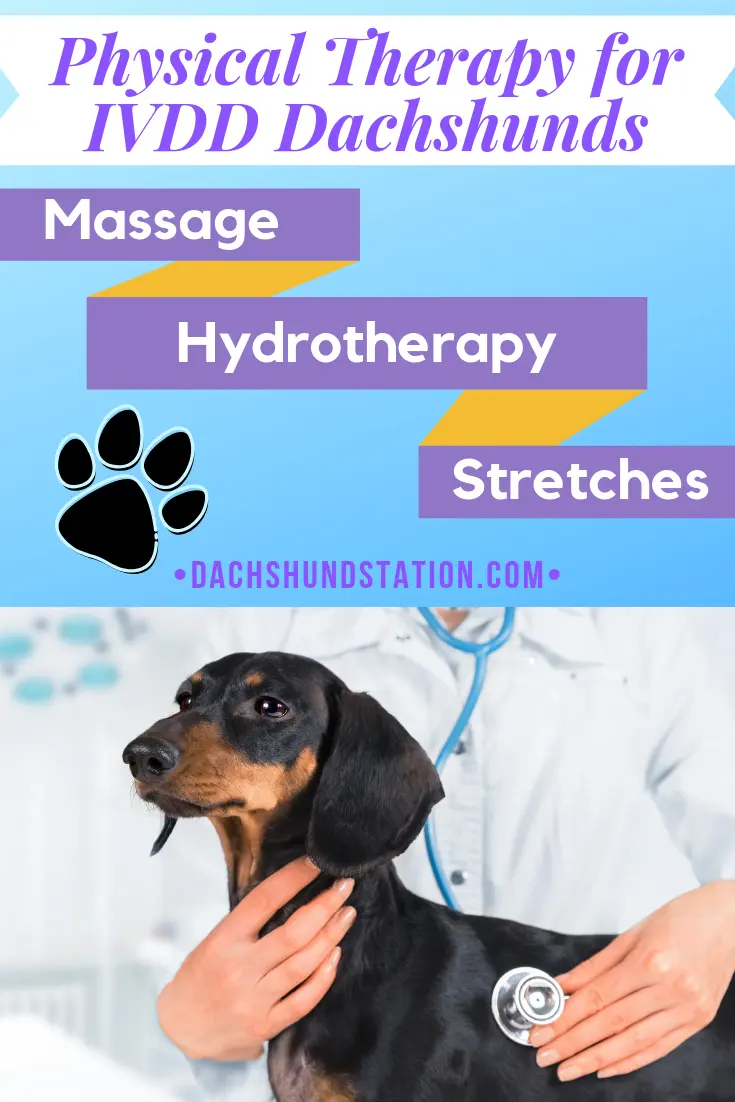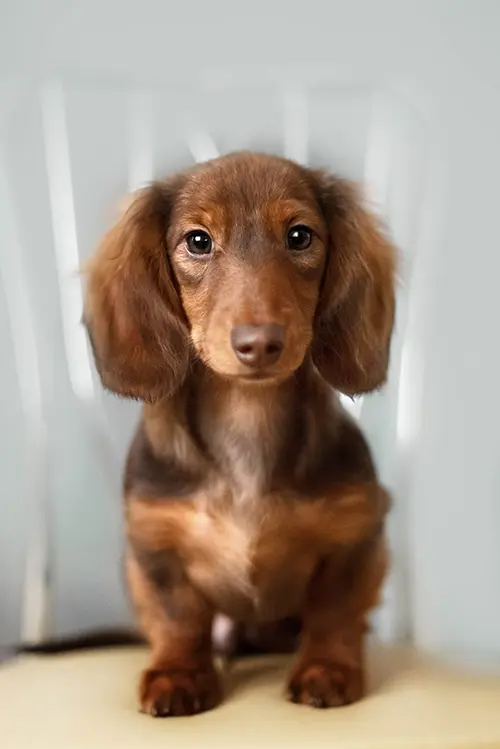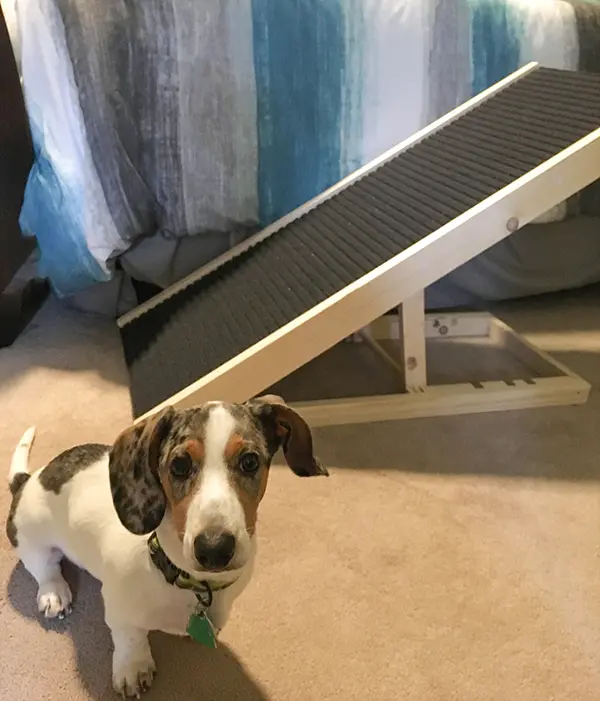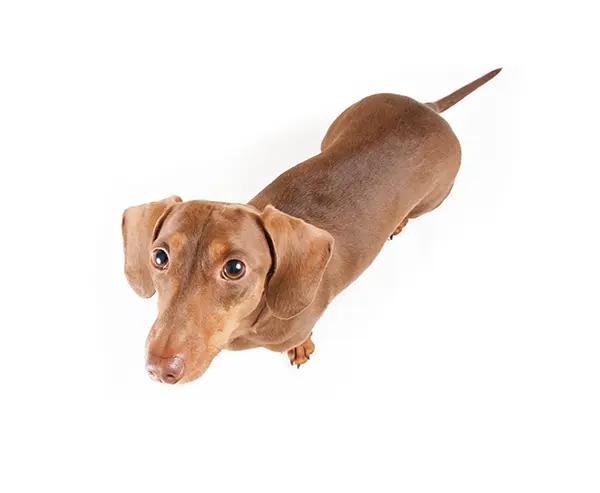
Successful Therapy for Dachshunds with IVDD
IVDD can be a scary diagnosis for any Dachshund owner. Don’t lose hope! There are many Successful Therapy Options for Dachshunds with IVDD, with or without surgery.
This page contains affiliate links and I earn a commission if you make a purchase through one of the links, at no cost to you. As an Amazon Associate, I earn from qualifying purchases.
Treatment methods for IVDD include Hydrotherapy, Laser Therapy, Acupuncture, Stem Cell Therapy, and Physical Therapy exercises.
Table of Contents
What is IVDD?
Intervertebral disc disease, also known as IVDD or slipped disc disease, is an inherited condition of the spine.
IVDD is a disease caused by progressive degeneration of the intervertebral disks.
As the disks degenerate, they calcify and lose their shock-absorbing ability. The disks will then become more susceptible to compression damage, even from normal activities.
The contents of the disks will then go into the spinal canal and place pressure on the spinal cord. Severe or prolonged pressure on the nerves can lead to pain, loss of bladder or bowel control, or even paralysis, to the spinal cord. [2]

How Long Does IVDD Take to Heal?
After IVDD surgery, your dog will need crate rest, pain management, and physical therapy for about 6-8 weeks in order to properly heal.
It is important to have physical therapy scheduled for your dog after surgery to help them regain their strength, because many doxies do walk again.
Some physical therapy can be done at home, while others will require you to take your dog to a qualified canine rehabilitation therapist (either a Physiotherapist or Veterinary Surgeon).
Emergency Symptoms Post-Op Recovery:
If any of the following symptoms occur while your Dachshund is recovering from IVDD surgery, call your vet ASAP:
- Pain, weakness, or immobility
- Vomiting or diarrhea
- Difficulty with urinating or defecating
- Blood in the urine or stools
- Stops eating or drinking
- Acting lethargic
Treating IVDD in Dogs
Treatments for IVDD can go one of two ways: Conservative (non-surgical) or Surgical. It all depends on the severity of the damage to the spinal cord.
1. Conservative Treatment Method: (No-Surgery)
The Conservative Treatment Includes:
- Anti-inflammatory medication from your vet
- Crate rest for 6-8 weeks
- Reduction of Activities
Can a Dog Recover from IVDD Without Surgery?
The conservative method is not the “cure all” for IVDD. It is a treatment for the current spinal problem in order to help the dog heal.
When my miniature dachshund, Reno, occasionally would have issues walking. My vet gave him some medication to help reduce the inflammation and pain he was experiencing. That really helped him get back to feeling like himself again.
Check out the YouTube Video IVDD in Dogs: JP’s Story. JP was able to walk again using conservative treatment methods. Credit to Southern Cross Vet Clinic cc.
2. Surgical Treatment Method
“If the damage is too severe and the dog is paralyzed or incontinent, conservative treatment may not be enough. In many cases, emergency surgery is needed to open up space. This is done by removing a portion of the bony vertebrae over the spinal cord (laminectomy). Even after surgery, however, the dog may not recover fully.” [7]
At the first sign of IVDD Symptoms, it is crucial to get your dog to the vet. If surgery is required, the sooner they have the operation the better chances of success they have to be able to walk again.
It is recommended that you have your dog’s surgery done by a trained neurologist, not a general veterinarian.
If successful, this surgery may fix the injured discs, but with IVDD, it is unfortunately possible that other discs can rupture in the future.

Successful Therapy for Dachshunds with IVDD
IVDD rehabilitation services consist of progressive treatment plans that address your dog’s strength, range of motion, pain, balance, and mobility. Some treatment methods include the following:
- Hydrotherapy
- Laser Therapy
- Acupuncture
- Stem Therapy
- Physical Therapy Exercises
These methods can be used as conservative treatments or post – surgery treatments.
Hydrotherapy:
Hydrotherapy means “Water-Healing.” This type of therapy involves your dog swimming and the using an underwater treadmill. Being in the water creates resistance and will cushion your dog’s joints.
How Does Hydrotherapy work for dogs?
Post-Op Hydrotherapy Story:
Viivi, the wire-haired miniature dachshund contracted IVDD when she was just 4 years old. Check out Viivi’s Story for details on her symptoms, surgery, and rehabilitation.

Laser Therapy:
With the help of Laser Therapy, Dogs that are not able to stand or walk can regain strength and get back to normal doggie activities.
Laser Therapy reduces IVDD pain naturally and helps speed up healing time.
Is Laser Therapy Effective For Dogs?
Laser Therapy works directly on the affected areas. It can strengthen your dog’s muscles and improve mobility.
The LumaSoothe LED Laser device pictured below is one of the ‘lower cost’ laser therapy devices available for home use. (This is an affiliate link from the LumaSoothe Amazon Store).
Please Note: LED Light Therapy at home is safe and effective, however, always avoid direct contact with your eyes and your dog’s eyes.
Read more about Cold Laser Therapy for IVDD from our friends at You Did What With Your Weiner.
Acupuncture:
The Acupuncture method used for IVDD reduces swelling, pain, and inflammation. Acupuncture can restore the damaged nerves and promote faster healing.
Stem Cell Treatment:
Many studies are underway using Stem Cell treatment for dogs with IVDD. Check out Jasper the Dachshund’s story on YouTube and how he regained his mobility using Stem Cell Treatment.
Physical Therapy Exercises For Dogs With IVDD:
The following are a list of exercises your dog may need to do post IVDD surgery. Only do the exercises that your vet recommends for your dog.
Natural Supplements For Dogs With IVDD:
There are two natural supplements recommended for dogs with IVDD: turmeric and omega-3s.
Note: I am not a veterinarian. I am suggesting products that I have researched. Always check with your Vet before giving your dog any supplements.
1. Turmeric
Turmeric can help dogs who suffer from chronic joint pain by reducing inflammation.
You can add this supplement to your dog’s food, or purchase a soft chewable tablet on Amazon.
Keep in mind, not all dogs can tolerate turmeric. It is a warming supplement, so if your dog seems pant a lot or sleeps on the cool floor, skip the turmeric.
Caution: If your dog’s on any medications, check with your vet before adding turmeric to her diet. Turmeric can interact with some medications, including anti-inflammatory and diabetes drugs, and chemotherapy treatments.
2. Omega-3s
Omega-3s can help dogs who suffer from joint pain by reducing inflammation. Avoid purchasing “Fish Oil” based Omega-3s for dogs because it can be toxic.
Read more about Omega-3s for Dogs from Dogs Naturally Magazine.
Dachshund Mobility Aids
In addition to the above treatment options, you may also want to try a mobility aid for your doxie. You can equip your dog with some wheels or a supportive back brace to help them get around with ease.
Dachshund Ramp:

Harness and Sling:
This dog support harness and rehab sling gently loops under your doxie, just in front of the back legs.
I recommend pairing the rehab sling with the IVDD-friendly harness from DJANGO for extra strong support. Use code DACHSHUNDSTATION for 10% off on DJANGO.
Note: The Django Brand link is an affiliate link and I will receive a commission if you click through and make a purchase, at no cost to you.
As a part of IVDD recovery and prevention, a canine orthopedic back brace (recommended by your vet) can also help your Dachshund regain their strength and sense of independence.
Dachshund Wheelchairs:
Your dog’s vet can help you find or customize a special wheelchair for your dachshund with IVDD.
A doggie wheelchair can provide excellent support for dogs that suffer from weakness or paralysis.
Here are a couple of options for you:
Will My Dog Recover From IVDD?
Conclusion:
Unfortunately, IVDD can keep your dachshund from doing all of his favorite things: playing, jumping, and digging. Using IVDD prevention tips can help reduce the risk of your dog getting IVDD.
If your Dachshund has been through IVDD, please post some lessons learned in the comments below. We would love to hear from you.
Up Next: Best Harnesses For Dachshunds


Helpful Resources:
- DodgersList IVDD Forum: Learn more from other dog moms and dads about IVDD.
- What is the cost of IVDD Surgery for Dogs?
- IVDD Info on Pinterest
- DodgersList Physiotherapy YouTube Channel for a post-operative paralyzed dogs.
- Crate rest for dogs: advice for vets by Dr. Marianne Dorn.
Sources:
- Schweitzer, Karen. 2010. Our Best Friends: The Dachshund. Pittsburg, PA: Eldorado Ink.
- Pinney, Chris C. 2010, 2000. Hauppauge, NY 11788.
- NorthStar VETS Vet, NJ. Avoiding back problems in Dachshunds
- UCDAVIS Veterinary Medicine.
- Dachshund Health UK
- Pet Health Network
- PetMD
- Dogs Naturally Magazine

Hello,
I am currently experiencing IVDD surgery angst with my 5 year old dachshund Frank. I adopted him from a shelter only a few months ago. I make Frank breakfast every morning and dinner at night. He is usually outside so I call him to let him know food is ready. He usually comes running and I can hear his tag ring but one morning I didn’t. So I checked outside to see what he was up to and there he was, dragging his hind legs across the yard trying to get to his food! Poor thing! My heart dropped and I drove him to the ER right away!
It’s day 3 today after surgery and Frank still has not moved his legs but has shown signs of involuntary control of his bladder and tail so that is a good sign that he will walk again.
Thank you for the advice and tips on nutrition. I am praying that Frank will walk again soon!
Hello, Thank you very much for sharing. I’m so glad that he is showing good signs of recovery. Keep up the good work! Sending lots of prayers for Frank.
Thank you for posting this, especially about the natural supplements that could be helpful. My eight year old dachshund Weenie severely injured her back and it was discovered she had IVDD when I came home from work one day and she was jumping upright at the door- her sounds went from happy excited ones to excruciating pain squals ): I got the door open as fast as I could but she was completely paralyzed on the hind end. She had surgery the next morning and is now back to about 95% the normal mobility she had before and it’s been 11 weeks. It was a horrifying experience and I was afraid she would never walk again, she had a significant herniation where almost 50% of her spinal cord was compressed. Now I am curious if I should be allowing her to run with me or run at all? She used to be my running partner and she loves to run, but she’s getting older and I don’t want to overdo it. I will consult with our veterinarian. I am considering supplements and she is on strict no jumping rules which has been tough because she was one bouncy dog. She now has a crate while I’m away at work. Again thank you for the post I enjoyed reading about IVDD therapies.
Hi There, Thank you so much for sharing your experience with me. I know that every doxie has a different story and so many dachshund parents look for knowledge from experienced folks like you. I’m so glad that your dachshund has successfully come through the surgery and is able to walk again. Did she do some physical therapy after the surgery at home or at a rehabilitation center?
I would consult a canine physical therapist and your vet on the running question. I know that keeping her moving helps, but running may be on the risky side – as IVDD can happen again. It is so hard to keep a doxie from running, playing, jumping because they just love life and don’t want to sit still. Kudos to you for getting through those long 11 weeks.
Thank you for your article. Physical therapy is really important for dachshunds. I live in Kronstadt, Russia. For 2 months now, my Dachshund Alison has been undergoing rehabilitation after surgery. On the right hind leg, she got up very quickly, on the left in just 2.5 weeks. Of course, Alison is running like lightning right now. But the slow gait is like a duck’s. We’re still trying to fix the limp in her left leg. We do exercises (squats, stepping over cavaletti rails, walking backwards, climbing a ramp, using a balancing disc), massage, go on a water treadmill, swim in the bathroom, use a darsonval, undergo acupuncture (she really doesn’t like it). At the moment, the improvements are almost not noticeable. Only the muscles in his legs gave way. For walking on the left hind leg, we wear a protective sock to prevent the claws from being worn down to the base. We use a short leash for better control of the dog. I am constantly looking for new information on postoperative rehabilitation of dogs with IVDD. But it’s basically the same everywhere. Even on instagram, Dachshund owners don’t like to describe the details of their rehabilitation. It is sad. I think that the owners of dachshunds should be more open about this issue. That’s why we have created our own instagram account, where we describe our rehabilitation process. I was very interested in your recommendation about turmeric and omega-3. I’m going to ask our doctor about it. We’re not going to stop. And we will continue our recovery work.
Hello Yana, Thank you so much for letting us know about Alison’s rehabilitation process after her surgery. It sounds like you have her on a pretty serious schedule to help her recover, awesome! We appreciate all of her therapy details, thank you. So many of us don’t know what to expect with IVDD or spinal issues occur. This helps a lot. Good luck and prayers for your dachshund, Alison. Take care.